S P E C I A L R E P O R T
III - Visit of the Scientific Advisory Board to INESC Porto
UTM achieves scientific results and application areas 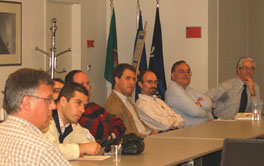
Until October 2006, BIP’s Special will be dedicated to the visit of the Scientific Advisory Board, namely, to the work each R&D Unit has had in preparing for the visit. In the third “chapter”, BIP interviewed José Ruela, the UTM’s coordinator, and Teresa Andrade, collaborator of this Unit. This Research Unit is informally organized in 3 groups: Communication Networks and Services, Multimedia Technologies and Systems and Optical and Electronic Technologies.
BIP: How did you prepare for the Visit?
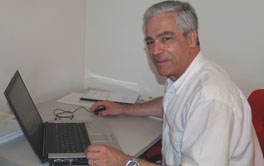 UTM: We had informal meetings with the Board, followed by conversations between the people in charge and the unit projects. In those meetings, we decided the type of presentations to prepare in terms of size, structure and message to send out. We also decided that it would be advantageous to prepare some back-up posters and demonstrations, to be shown only in case the evaluator is interested in it. UTM: We had informal meetings with the Board, followed by conversations between the people in charge and the unit projects. In those meetings, we decided the type of presentations to prepare in terms of size, structure and message to send out. We also decided that it would be advantageous to prepare some back-up posters and demonstrations, to be shown only in case the evaluator is interested in it.
BIP: What image of unit(y) did you show the Scientific Board?
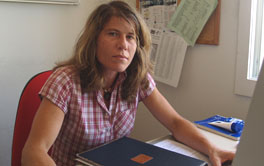 UTM: The Unit covers a wide diversity of research topics which explains its current organization in three areas. Considering this, the first concern was to present each one of the areas and respective strategies, highlighting the main orientation lines and objectives and the coherence of the integration of the main topics of research around the great mobilizing projects and post-graduate training. Although the areas are not (or shouldn’t be) shiftless, the truth is their synergies have not yet been fully articulated nor explored; this aspect was visible during the visit, as concluded by the Board, and it is, naturally, an aspect worth reflecting upon in the short run. UTM: The Unit covers a wide diversity of research topics which explains its current organization in three areas. Considering this, the first concern was to present each one of the areas and respective strategies, highlighting the main orientation lines and objectives and the coherence of the integration of the main topics of research around the great mobilizing projects and post-graduate training. Although the areas are not (or shouldn’t be) shiftless, the truth is their synergies have not yet been fully articulated nor explored; this aspect was visible during the visit, as concluded by the Board, and it is, naturally, an aspect worth reflecting upon in the short run.
BIP: What was the presentation? What objectives did you try to accomplish?
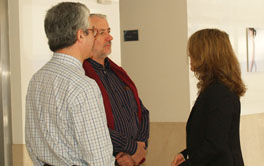 UTM: Initially, the coordinator (José Ruela) introduced the Unit. He focused on strategic and organizational aspects, while briefly characterizing the areas and analyzing the performance indicators of the last four years. After some considerations on the future of the Unit, he proposed the plan for the visit, organized around each one of the areas according to a common model. Thus, Henrique Salgado, Teresa Andrade and Manuel Ricardo presented their areas and addressed several topics, ongoing research activities and the respective contributions to accomplish the strategic objectives identified in each one of them. A background of the existing competences was offered, with reference to the main research projects and partnerships as well as to the main results obtained. The capital orientation lines in the short and medium run were also outlined. Next, there was a visit to the laboratories in which the researchers participated more actively, whether in selected demonstrations or in the detailed discussion of R&D activities and their framing in the Unit’s and INESC Porto’s strategy. UTM: Initially, the coordinator (José Ruela) introduced the Unit. He focused on strategic and organizational aspects, while briefly characterizing the areas and analyzing the performance indicators of the last four years. After some considerations on the future of the Unit, he proposed the plan for the visit, organized around each one of the areas according to a common model. Thus, Henrique Salgado, Teresa Andrade and Manuel Ricardo presented their areas and addressed several topics, ongoing research activities and the respective contributions to accomplish the strategic objectives identified in each one of them. A background of the existing competences was offered, with reference to the main research projects and partnerships as well as to the main results obtained. The capital orientation lines in the short and medium run were also outlined. Next, there was a visit to the laboratories in which the researchers participated more actively, whether in selected demonstrations or in the detailed discussion of R&D activities and their framing in the Unit’s and INESC Porto’s strategy.
BIP: What should UTM expect in the future?
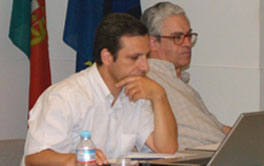 UTM: We believe that, scientifically, the orientation lines established in each area are clearly identified and they will be carried out successfully. We hope the existing know-how, the results obtained and the capacity to integrate them enable the reinforcement of some aspects that have turned out to be rather fragile, namely in the areas of advisory and technology transfer. UTM: We believe that, scientifically, the orientation lines established in each area are clearly identified and they will be carried out successfully. We hope the existing know-how, the results obtained and the capacity to integrate them enable the reinforcement of some aspects that have turned out to be rather fragile, namely in the areas of advisory and technology transfer.
BIP: Future activities?
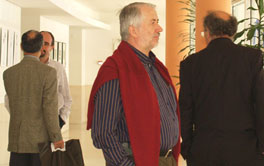 UTM: We don’t think it is necessary (and that wouldn’t be feasible) to work on great changes in terms of the main work areas in which the Unit invested and in which it was possible to create critical mass and obtain promising results. It is, however, necessary to establish a bigger and better interconnection between the scientific results and the application areas in which they can be valued, opening, if necessary, new work lines in close areas. We also need to rethink some organization aspects, in order to increase the internal cohesion and avoid some effort dispersion. UTM: We don’t think it is necessary (and that wouldn’t be feasible) to work on great changes in terms of the main work areas in which the Unit invested and in which it was possible to create critical mass and obtain promising results. It is, however, necessary to establish a bigger and better interconnection between the scientific results and the application areas in which they can be valued, opening, if necessary, new work lines in close areas. We also need to rethink some organization aspects, in order to increase the internal cohesion and avoid some effort dispersion.
The R&D activities will occur under European projects for the Sixth Framework Programme, in which the Unit has been and is still strongly involved and under new projects in progress to submit to the FCT’s R&D Projects contest which we are expecting to be approved. As mentioned above, efforts are being made towards the application of know-how and existing results in new advisory contracts, development and technology transfer.
BIP: Which new partnerships are you expecting the Unit to establish?
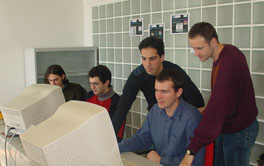 UTM: We are hoping to continue (or restart) working with our traditional partners both national and international, including operators and Telecommunications Services Suppliers, broadcasters, content generators, equipment manufacturers and systems integrators. UTM: We are hoping to continue (or restart) working with our traditional partners both national and international, including operators and Telecommunications Services Suppliers, broadcasters, content generators, equipment manufacturers and systems integrators.
We have already established solid bonds with some interesting partners, especially European, and we are most likely to keep those partnerships. However, during the presentations, the members of the Board who were in UTM acknowledged that we should try to gain some independence, even in psychological terms, from our national strategic partners. This recommendation will be thoroughly considered. |


 UTM: We had informal meetings with the Board, followed by conversations between the people in charge and the unit projects. In those meetings, we decided the type of presentations to prepare in terms of size, structure and message to send out. We also decided that it would be advantageous to prepare some back-up posters and demonstrations, to be shown only in case the evaluator is interested in it.
UTM: We had informal meetings with the Board, followed by conversations between the people in charge and the unit projects. In those meetings, we decided the type of presentations to prepare in terms of size, structure and message to send out. We also decided that it would be advantageous to prepare some back-up posters and demonstrations, to be shown only in case the evaluator is interested in it.  UTM: The Unit covers a wide diversity of research topics which explains its current organization in three areas. Considering this, the first concern was to present each one of the areas and respective strategies, highlighting the main orientation lines and objectives and the coherence of the integration of the main topics of research around the great mobilizing projects and post-graduate training. Although the areas are not (or shouldn’t be) shiftless, the truth is their synergies have not yet been fully articulated nor explored; this aspect was visible during the visit, as concluded by the Board, and it is, naturally, an aspect worth reflecting upon in the short run.
UTM: The Unit covers a wide diversity of research topics which explains its current organization in three areas. Considering this, the first concern was to present each one of the areas and respective strategies, highlighting the main orientation lines and objectives and the coherence of the integration of the main topics of research around the great mobilizing projects and post-graduate training. Although the areas are not (or shouldn’t be) shiftless, the truth is their synergies have not yet been fully articulated nor explored; this aspect was visible during the visit, as concluded by the Board, and it is, naturally, an aspect worth reflecting upon in the short run. UTM: Initially, the coordinator (José Ruela) introduced the Unit. He focused on strategic and organizational aspects, while briefly characterizing the areas and analyzing the performance indicators of the last four years. After some considerations on the future of the Unit, he proposed the plan for the visit, organized around each one of the areas according to a common model. Thus, Henrique Salgado, Teresa Andrade and Manuel Ricardo presented their areas and addressed several topics, ongoing research activities and the respective contributions to accomplish the strategic objectives identified in each one of them. A background of the existing competences was offered, with reference to the main research projects and partnerships as well as to the main results obtained. The capital orientation lines in the short and medium run were also outlined. Next, there was a visit to the laboratories in which the researchers participated more actively, whether in selected demonstrations or in the detailed discussion of R&D activities and their framing in the Unit’s and INESC Porto’s strategy.
UTM: Initially, the coordinator (José Ruela) introduced the Unit. He focused on strategic and organizational aspects, while briefly characterizing the areas and analyzing the performance indicators of the last four years. After some considerations on the future of the Unit, he proposed the plan for the visit, organized around each one of the areas according to a common model. Thus, Henrique Salgado, Teresa Andrade and Manuel Ricardo presented their areas and addressed several topics, ongoing research activities and the respective contributions to accomplish the strategic objectives identified in each one of them. A background of the existing competences was offered, with reference to the main research projects and partnerships as well as to the main results obtained. The capital orientation lines in the short and medium run were also outlined. Next, there was a visit to the laboratories in which the researchers participated more actively, whether in selected demonstrations or in the detailed discussion of R&D activities and their framing in the Unit’s and INESC Porto’s strategy.  UTM: We believe that, scientifically, the orientation lines established in each area are clearly identified and they will be carried out successfully. We hope the existing know-how, the results obtained and the capacity to integrate them enable the reinforcement of some aspects that have turned out to be rather fragile, namely in the areas of advisory and technology transfer.
UTM: We believe that, scientifically, the orientation lines established in each area are clearly identified and they will be carried out successfully. We hope the existing know-how, the results obtained and the capacity to integrate them enable the reinforcement of some aspects that have turned out to be rather fragile, namely in the areas of advisory and technology transfer.  UTM: We don’t think it is necessary (and that wouldn’t be feasible) to work on great changes in terms of the main work areas in which the Unit invested and in which it was possible to create critical mass and obtain promising results. It is, however, necessary to establish a bigger and better interconnection between the scientific results and the application areas in which they can be valued, opening, if necessary, new work lines in close areas. We also need to rethink some organization aspects, in order to increase the internal cohesion and avoid some effort dispersion.
UTM: We don’t think it is necessary (and that wouldn’t be feasible) to work on great changes in terms of the main work areas in which the Unit invested and in which it was possible to create critical mass and obtain promising results. It is, however, necessary to establish a bigger and better interconnection between the scientific results and the application areas in which they can be valued, opening, if necessary, new work lines in close areas. We also need to rethink some organization aspects, in order to increase the internal cohesion and avoid some effort dispersion.  UTM: We are hoping to continue (or restart) working with our traditional partners both national and international, including operators and Telecommunications Services Suppliers, broadcasters, content generators, equipment manufacturers and systems integrators.
UTM: We are hoping to continue (or restart) working with our traditional partners both national and international, including operators and Telecommunications Services Suppliers, broadcasters, content generators, equipment manufacturers and systems integrators.